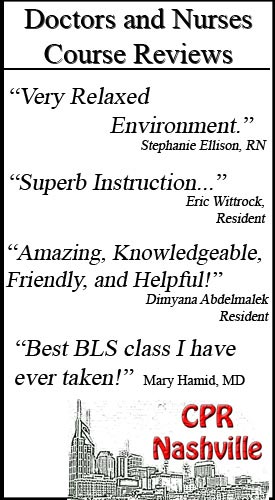Hs and Ts of Cardiac Arrest
CPR Nashville teaches Advanced Cardiac Life Support Classes in the Nashville Tennessee area to healthcare providers such as doctors, nurses, paramedics, surgeons, etc. In the course, you are required to learn the Hs and Ts of assessing cardiac arrest. The Hs and Ts are a mnemonic device for recognizing signs and symptoms of cardiac arrest. The following is a list of all the Hs and Ts.
Defined:
In hypovolemic shock, there is reduced intravascular blood volume. This causes circulatory dysfunction and inadequate tissue perfusion.
If left untreated, hypovolemic shock can lead to cardiac arrest, irreversible brain and kidney damage, and ultimately death.
Causes:
Acute blood loss, Dehydration, Diabetes Insipidus, Diuresis, Peritonitis, Severe Diarrhea/Vomiting
Signs and Symptoms:
- cold, pale, and clammy skin
- decreased sensorium
- rapid, shallow respirations
- hypotension
- tachycardia
- decreased urine output (less than 25ml per hour)
Treatment:
- Blood and Fluid Replacement
- Control of Bleeding if indicated
Hypoxia –
Defined:
A pathological condition in which the body as a whole (generalized hypoxia) or a region of the body (tissue hypoxia) is deprived of adequate oxygen supply
Causes:
Trauma, impaired gas exchange r/t COPD, other lung disease, pneumonia, pneumothorax, pulmonary embolism, pulmonary edema, obstruction
Symptoms:
- Restlessness
- Anxiety
- Cyanosis
- Disorientation, confusion,
- listlessness
- Headache
Treatment:
Supplemental Oxygen, Mechanical Ventilation, Find the cause of hypoxia
Hydrogen ion (acidosis)
Metabolic Acidosis Defined:
State of excess acid accumulation and deficient base bicarbonate. Symptoms are a result of the body’s attempt to compensate for and correct the acidotic condition.
Causes:
anaerobic metabolism- lactic acid production, chronic alcoholism, diabetic ketoacidosis, diarrhea, low carb/high-fat diet, malnutrition, renal insufficiency/failure (kidneys regulate hydrogen ions H+ and bicarbonate ion HCO3–
Signs and Symptoms:
- drowsiness
- headache
- Kussmaul’s respirations (a form of hyperventilation, deep, labored, gasping)
- lethargy/stupor
- ABG results pH below 7.35 and a Bicarbonate level less than 24mEq/L
Treatment:
- Treatment of the underlying symptoms
- Endotracheal intubation and mechanical intubation to ensure adequate respiratory compensation
- Intravenous administration of Sodium Bicarbonate
- **If the cause is diabetic ketoacidosis- administer insulin and IV fluids
Respiratory Acidosis Defined:
An Acid-base disturbance characterized by excess of CO2 in the blood (hypercapnia). It is the result of a reduction in alveolar ventilation either from acute or chronic lung conditions (PE vs. COPD)
Causes:
airway obstruction, CNS trauma, chronic metabolic acidosis, opioids, anesthetics, neuromuscular diseases
Signs and Symptoms:
- tachycardia, hypertension, arrhythmias
- coma
- confusion
- dyspnea and tachypnea
- headaches
- tremors
- hypoxemia
- PaCO2 exceeds 45mmHg and pH is usually below 7.35.
Treatment:
- Treatment of the underlying symptoms
- Endotracheal intubation and mechanical intubation if needed
- Intravenous administration of Sodium Bicarbonate (severe cases)
- Dialysis to remove toxic drugs
- Bronchodilators
- Removal of Foreign bodies if appropriate
Defined:
Hypokalemia is a metabolic disorder that occurs when the level of potassium in the blood drops too low. Normal serum potassium levels are 3.5 to 5.5 mEq/L.
Potassium is needed for cells, especially nerve and muscle cells, to function properly. You get potassium through food. The kidneys remove excess potassium in the urine to keep a proper balance of the minerals in the body.
Causes:
Diarrhea, Diuretic medications, kidney diseases, Sweating, vomiting, eating disorders
Signs and Symptoms:
- Muscle Weakness/Spasms
- Alkalosis
- Irritability
- confusion, drowsiness
- Arrhythmias
- Decreased intestinal motility
Treatment:
Potassium Replacement
Defined:
Hyperkalemia is defined as a potassium level greater than 5.5 mEq/L.Ranges are as follows: 5.5-6.0 mEq/L – Mild, 6.1-7.0 mEq/L – Moderate, 7.0 mEq/L and greater – Severe
Causes:
Decreased Potassium Excretion r/tRenal Failure, acidosis, overuse of potassium supplements, trauma, burns, medication combinations
Signs and Symptoms:
- Muscle Twitching
- Cramps
- Paresthesia
- hypotension
- ECG Changes
- Dysrhythmias/Irregular Rhythm
- Diarrhea/Abdominal cramping
Treatment:
Variety of medications dependent on cause and physician choice
Hypoglycemia –
Defined:
Hypoglycemia is a condition that occurs when your blood sugar (glucose) is too low. Blood sugar below 70 mg/dL is considered low. Blood sugar at or below this level can harm you. ***can lead to coma if not corrected
Causes:
Diabetes, drinking alcohol, insulinoma (tumor in the pancreas), infections, severe kidney or liver failure
Signs and Symptoms:
- Sweating
- feeling nervous
- hungry
- blurred or double vision
- shaky
- irritable
- cool, clammy skin
- feeling faint
Treatment: Depends on cause. Glucose. Administer Dextrose can be administered IV in acute situations.
Defined:
a condition in which core temperature drops below the required temperature for normal metabolism and body functions which is defined as 35.0 °C (95.0 °F).
Cardiac Tamponade –
Defined:
Pressure on the heart occurs when blood or fluid builds up in the space between the heart muscle (myocardium) and the outer covering sac of the heart (pericardium). The rapid rise in pressure impairs the diastolic filling of the heart.
Causes:
Acute Myocardial Infarction, Thoracic Aortic Aneurysm, Lung Cancer, Pericarditis, Trauma, ETC.
Signs and Symptoms:
- Jugular Vein Distension
- Anxiety
- Dyspnea, rapid breathing
- Muffled Heart Sounds on Auscultation
- Diaphoresis
- Chest Pain
- Pale, blue, or grey skin color
- dizziness/lightheadedness
- weak or absent pulse
Treatment:
- The fluid around the heart must be drained as quickly as possible. Pericardiocentesis is a procedure that uses a needle to remove fluid from the pericardial sac, the tissue that surrounds the heart.
- A procedure to cut and remove part of the pericardium (surgical pericardiectomy or pericardial window) may also be done.
- Fluids are given to maintain normal blood pressure until pericardiocentesis can be performed. Medications that increase blood pressure may also help sustain the patient’s life until the fluid is drained.
- The patient may be given oxygen. This reduces the workload on the heart by decreasing tissue demands for blood flow.
- The cause of tamponade must be identified and treated.
Defined:
A tension pneumothorax occurs secondary to blunt or penetrating injury of the lung which results in a one-way valve being created. Air leaks from the lung out into the pleural space and is unable to escape, resulting in increased intrapleural pressure. Intrapleural pressure eventually increases to the point where it interferes with venous return, resulting in blood pooling in capacitance vessels with ensuing cardiovascular collapse and shock.
Causes:
Blunt chest trauma, penetrating chest injuries, thoracentesis, central venous catheter insertion
Signs and Symptoms:
- anxiety
- diaphoresis, pallor
- diminished or absent breath sounds
- Hypotension
- tachycardia
- Decreased chest expansion unilaterally
- dyspnea, tachypnea, subcutaneous emphysema
- sharp pain that increases with exertion
Treatment:
- Oxygen therapy
- chest tube
- thoracentesis
- incentive spirometer
Thrombosis – Coronary/Pulmonary
Defined:
The formation of a blood clot inside a blood vessel obstructs the flow of blood through the circulatory system. A clot that breaks free and begins to travel around the body is known as an embolus. When a thrombus occupies more than 75% of the cross-sectional area of the lumen of an artery, blood flow to the tissue supplied is reduced enough to cause symptoms because of decreased oxygen (hypoxia) and accumulation of metabolic products like lactic acid. More than 90% obstruction can result in anoxia, the complete deprivation of oxygen, and infarction, a mode of cell death.
Examples: Myocardial Infarction, Pulmonary Embolism, DVT, Stroke
Treatment: Depends on the type of thrombosis and severity of symptoms
Trauma –
Is the trauma causing hypovolemia?
Is there an electrolyte imbalance?
Is there brain trauma causing hemorrhage?
Causing ICP?
***Assess the trauma and patient. Treatment will be patient-specific.
Toxins –
Drug Overdose? Narcan and other reversal agents if indicated
Exposure to poison or other toxin – identify toxin and treat accordingly
Advanced Cardiac Life Support Nashville ACLS Class, ACLS certification Nashville TN









